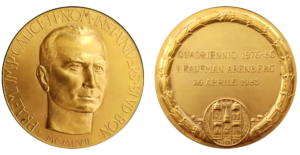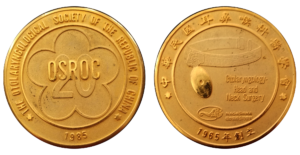About the author
about the author
I. Kaufman arenberg, MD
As one of my best friends’ moI have always had a sense of awe in his persona, his art, and his most unusual character and his art since I was a kid and loved the movie, LUST FOR LIFE with Kirk Douglas. When I studied art history in college, I had Vincent posters in my dorm room and read his letters where he described his “attacks” as “vertige” in French which can only mean inner ear vertigo, a primary characteristic of Meniere’s disease. Inner ear disorders and Meniere’s disease became my major area of interest and expertise as a neurotologist (an ear specialist), as one of my best friends’ mother had a violent vertigo attack in her kitchen while she was hand churning some ice cream for “the boys” in high school. We were all aghast. The dad said, “It’s ok boys, do not worry. She just had another Meniere’s attack.” That was my first experience with violent vertigo and Meniere’s disease, but I decided then after that traumatic event to become a doctor and figure out how to conquer that terrible disease.
I had learned early on about vertigo and Meniere’s disease. So, when I was reading van Gogh’s letters as an art history student in college, I realized when he wrote that his attacks were “vertige” that his attacks were not epilepsy but classical Meniere’s disease.
Years later I told an artist, who was about to go through inner ear surgery, “…not to worry as an artist because she had an excellent chance that the surgery would eliminate her vertigo.” She was more fortunate than Vincent who also had Meniere’s disease, but there were no treatments for him in the 1880s! Her surgery was successful. She was a co-author of our JAMA article.
Over the years, Vincent’s art, his life, his Meniere’s disease, and other eclectic aspects have played a significant part in my life and careers. When I did my initial research on Vincent for JAMA, I never believed Vincent committed suicide. It did not make any sense, but I was a very busy doctor and did not delve into the suicide versus murder story until after I saw the wonderful, animated movie, Loving Vincent. I walked out of that movie and said to my friend: “Loving Vincent–Killing Vincent made sense!” At that moment, I committed to writing Killing Vincent. And thus, was born the initiative for the Killing Vincent Project which continues to this day!
Being Vincent Van Gogh's "Ear Doctor"

Killing Vincent is meant as a historical analysis and exposé, attempting to continue exploring the key questions that TIME magazine asked in its October 31, 2011, cover story: “Who killed Vincent van Gogh?” and “Was van Gogh’s death really a suicide?” on the “Culture” Cover. I have attempted to answer both questions. This work is not meant as an academic treatise or dissertation, with every observation, thought, and detail requiring documentation. It is only an attempt as an expose’, to seek the truth of what really happened on the day Vincent van Gogh was mortally wounded, and to best connect all the missing “dots”. In the process, I will try to fit the best murder scenario into what little is really accepted, and why he was murdered… significantly changing art history.
I was Vincent’s ear doc in the sense that I read all of his 760 extant letters and used his, almost daily writings as if I was taking a medical history from him. He often wrote about how he was feeling, or what medical problems he was having. So, I made the diagnosis of Meniere’s disease from his handwritten clinical history describing his “attacks” as “vertige” provided. This was his own written description of his recurrent, intermittent malady. Thus, I was, diagnostically at least, in effect, “his ear doctor”.
overview
Dr. Arenberg was involved in making the diagnosis of Meniere’s disease and not epilepsy in Vincent van Gogh in 1990 to account for his violent “attacks” and hallucinations. He was an ear doctor and a distinguished ear surgeon and Neurotologist. He was an innovator in his field of inner ear surgery for Meniere’s disease with several medical devices/instruments bearing his name. He also had 12 US/International patents issued. He was an internationally recognized expert in inner ear hearing and balance diseases. Meniere’s disease, endolymphatic hydrops(ELH) and Electrocochleography (ECoG) for diagnostic and intra-operative monitoring of Meniere’s Disease and endolymphatic hydrops (ELH) surgery were of very special interest and focus during his medical career. He also co-innovated the ECoG inner ear intra-operative monitoring for surgical management of Meniere’s disease and endolymphatic hydrops. He created IntraEARÔ, Inc, a medical device drug delivery system entrepreneurial endeavor utilizing three of his own patents. IntraEARÔ, Inc was subsequently sold in 2000 (with a 3X profit for investors) to a Silicon Valley Pharma, before moving to NY for 10 years. In NY, he started a boutique Precious metal hedge fund. In this 3rd major career change, he was the portfolio manager. His fund resulted in a 10-year trading track record with a compound annual return in excess of 80% per year. This was achieved by aggressively trading options, futures as well as all mining stocks and Canadian junior exploration mining companies. He has retired and now devotes his time and efforts to his family, his German Shepherd, writing of several non-medical books, the arts, and non-profits.

major accomplishments



He received the highest award (a special Teacher-Investigators Traineeship Award) from National Institute of Health (NIH) while a resident (Only 5/year granted in 1973). He was also a Fellow in Otology-Neurotology, and NIH Special Teacher Investigator Trainee (NINDSC) and Visiting Scientist and Fellow of the Swedish Medical Research Council doing Clinical Meniere’s Disease Research at the Royal Academic Hospital (Akademiska Sjukhuset), University of Uppsala Medical School ( Orenkliniken), Uppsala, SWEDEN.
He also received several distinguished international awards including 3 gold medals; one The Pietro Calicetti Gold Medal Award from the University of Bologna, Bologna, ITALY, the second, The Gold Medal Honor Award for Meniere’s Disease Research from the ORL Congress, REPUBLIC OF CHINA, and the third, the Gold medal honor award winner for 2006, 25th Anniversary meeting of the Prosper Meniere Society in AUSTRIA, (which he founded in 1981).
Dr. Arenberg Has Received Three International Gold Medal Honor Awards for His Previous Publications
The Pietro Calicetti Gold medal Award from the University of Bologna, ITALY 1984
Gold Meal Honor Award from OSROC, Taipei, CHINA, 1987
Gold Medal Honor Award for Lifetime Acheivement, The Prosper Meniere Society, Zell, AUSTRIA
And several other international awards, as well over the years…but no medals.
